Overview
The article addresses the challenges developers face in coding, particularly regarding data management and compression. It introduces the Zstandard (zstd) compression algorithm in Golang as a solution, highlighting its superior compression ratios and speed compared to traditional algorithms.
By providing a structured approach, the article guides developers through the preparation steps, installation, integration, and validation processes for zstd. This implementation not only enhances performance but also boosts efficiency in managing data.
In addition, the article emphasizes the benefits of adopting zstd, encouraging developers to explore its capabilities for improved productivity and code quality.
Introduction
In the ever-evolving landscape of software development, developers often face significant challenges related to efficient data handling. Zstandard (zstd), a cutting-edge compression algorithm developed by Facebook, stands out as a game-changer. It offers remarkable compression ratios and rapid speeds that outshine traditional methods like gzip.
Furthermore, zstd's adaptability to various project needs not only minimizes file sizes but also optimizes resource usage, making it an essential tool for developers. As organizations increasingly embrace zstd for its superior performance, understanding its implementation in Golang projects becomes crucial.
This article delves into the myriad benefits of zstd, guiding developers through the process of setting up, integrating, and validating this powerful compression library in their applications.
Understand zstd and Its Benefits for Code Compression
Zstandard (zstd) stands out as a high-performance, lossless data reduction algorithm developed by Facebook, specifically tailored for real-time applications. Its advantages are noteworthy:
- Superior Compression Ratios: Zstd consistently surpasses traditional algorithms like gzip, achieving a remarkable compression ratio of 2.896. This efficiency is crucial for minimizing file sizes while safeguarding information integrity.
- Rapid Speed: With decompression rates soaring up to 1550 MB/s, this algorithm is perfect for applications demanding swift access to information, thereby enhancing overall system responsiveness.
- Versatile Flexibility: Zstd offers a broad spectrum of levels for data reduction, empowering developers to find the ideal balance between speed and effectiveness tailored to their specific project requirements.
- Efficient Resource Usage: Designed to minimize CPU usage during decompression, this algorithm proves especially advantageous for applications frequently accessing compressed data, ensuring optimal performance without excessive resource consumption.
Real-world applications of this data reduction method highlight its efficiency, particularly in scenarios where training dictionaries on available information can significantly enhance reduction ratios and speeds. The process of training dictionaries on coherent datasets is vital, as it yields improved outcomes, showcasing the dictionary's capabilities.
As industry experts note, the transition to this newer compression method from older algorithms like gzip is increasingly common, thanks to its superior performance and adaptability. Yann Collet, the project maintainer, emphasizes this shift, stating, "After being enlightened to all the advantages of Zstandard, I'll never casually use zlib again: it's just too slow and inflexible for the needs of modern computing." Developers are encouraged to explore zstd golang for their compression needs, as its benefits are evident in both speed and efficiency, making it a compelling choice for contemporary computing demands. Moreover, Zstandard's adoption in production environments by companies like Facebook underscores its relevance and effectiveness in the tech industry.
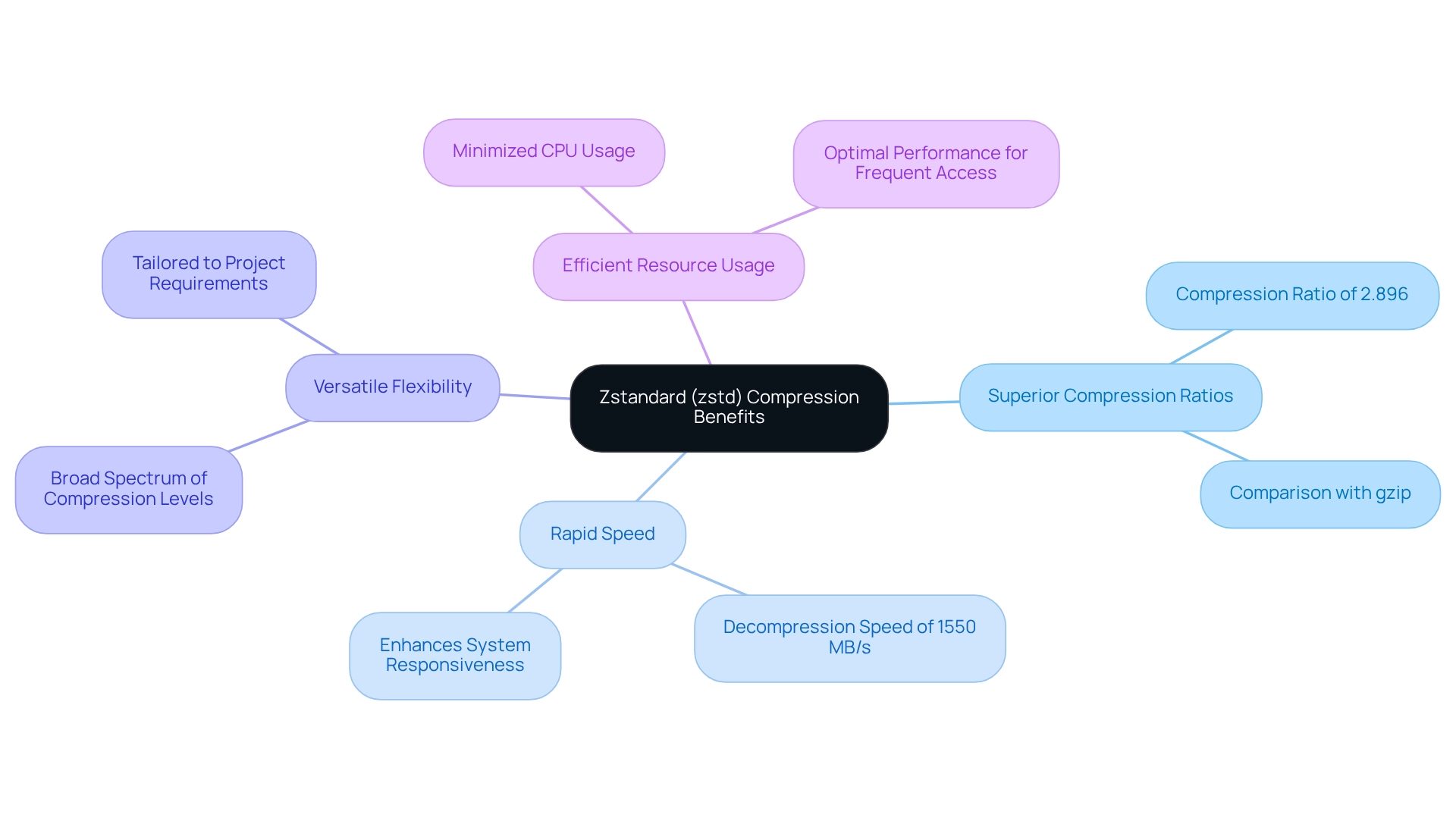
Prepare Your Environment for zstd Implementation
To effectively implement the compression algorithm in your Golang project, it’s crucial to establish a well-prepared development environment. Coding challenges often hinder developers from achieving their goals efficiently. So, how can you overcome these obstacles and streamline your process?
Begin by downloading and installing Go from the official website, ensuring you follow the specific instructions for your operating system. Organize your project files by creating a dedicated directory. Use the following commands:
mkdir my-zstd-project
cd my-zstd-project
Next, confirm that you are using a compatible version of Go by executing:
go version
Furthermore, depending on your project requirements, consider installing additional tools such as a code editor (e.g., Visual Studio Code) and version control systems (e.g., Git) to enhance your workflow. Remember, the best Golang IDE or editor fits your specific workflow and helps you to write cleaner code.
In addition, ensure that your GOPATH and GOROOT environment variables are correctly configured. You can verify this by running:
go env
By following these steps, you will establish a robust foundation for implementing zstd golang in your project, which aligns with best practices for Go development in 2025. This preparation not only streamlines your coding process but also enhances overall productivity. Effective communication and collaboration are essential in overcoming project challenges. Are you ready to take your development environment to the next level?
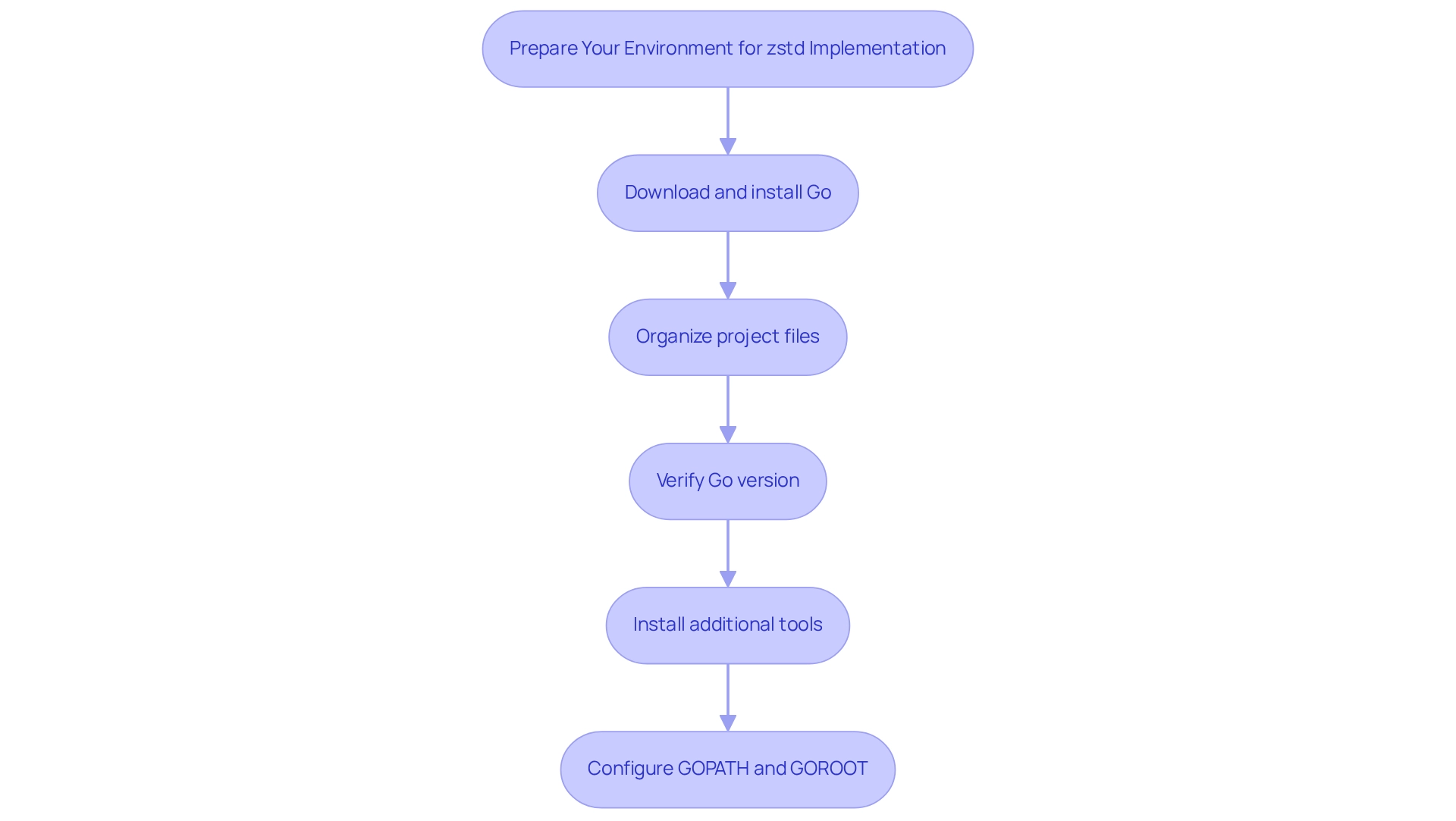
Install the zstd Library in Your Golang Project
In the world of software development, coding challenges can often hinder productivity. However, tools like Kodezi are designed to tackle these issues effectively. For instance, to install the zstd library in your Golang project, follow these steps:
-
Open Your Terminal: Navigate to your project directory where you wish to install the compression library.
-
Use Go Get Command: Execute the following command to install the zstd library:
go get -u github.com/klauspost/compress/zstdThis command retrieves the latest version of the zstd library and adds it to your project dependencies, ensuring you have access to the most recent features and optimizations.
-
Verify Installation: After installation, confirm that the library has been added by checking your
go.modfile. You should see an entry forgithub.com/klauspost/compress/zstd, indicating successful integration. -
Import the Library: In your Go files where you intend to utilize zstd, import the library at the top of your file:
import "github.com/klauspost/compress/zstd"
By completing these steps, you will have successfully installed the zstd library and are prepared to integrate it into your codebase. This library is known for its efficiency; for instance, it can compress a file like nyc-taxi-data-10M.csv from approximately 3.33 GB to about 922 MB in just over 13 seconds, achieving a speed of 227.68 MB/s. Such performance enhancements in data reduction tasks make it a valuable addition to your development toolkit. Furthermore, Kodezi's single-click code generation feature illustrates how tools of this nature can improve productivity by simplifying the coding process. Why not explore the tools available on the platform to see how they can enhance your coding experience?
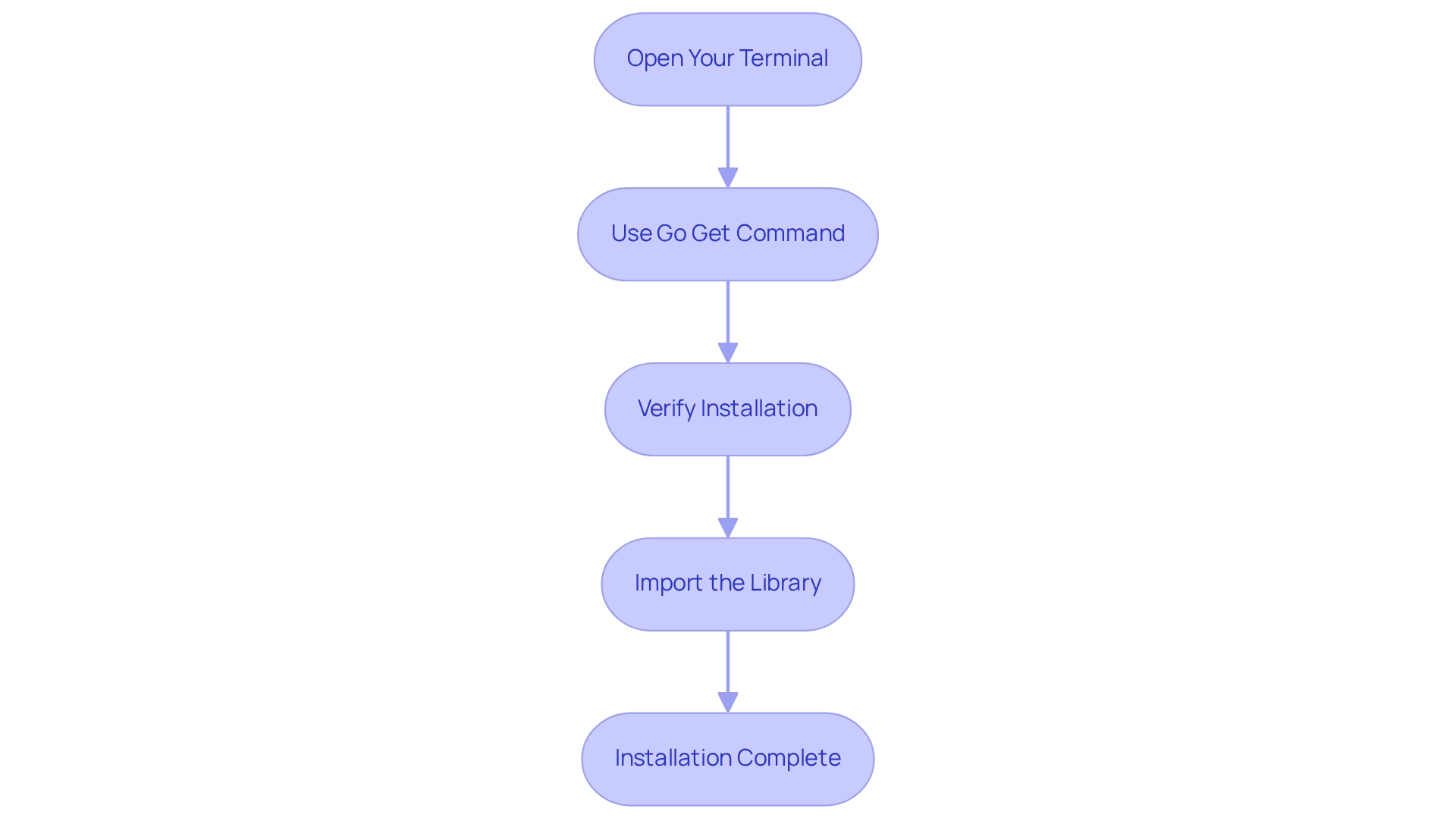
Integrate zstd Compression into Your Codebase
Incorporating zlib data reduction into your Golang codebase can significantly enhance performance and efficiency. Have you ever faced challenges with data size and processing time? A recent examination of the nyc-taxi-data-10M.csv file revealed that with zlib at level 4, the input size of 3,325,605,752 bytes was reduced to an output size of 474,949,772 bytes, requiring only 138,025 milliseconds for the process. This demonstrates the substantial performance benefits of using zstd golang in applications. Follow these best practices to implement it effectively:
-
Create a Compression Function: Begin by defining a function to manage compression. Here’s a straightforward example:
func compressData(data []byte) ([]byte, error) { var compressedData []byte var err error compressedData, err = zstd.Compress(nil, data) return compressedData, err } -
Utilize the Compression Function: Invoke this function whenever you need to compress information in your application. For instance:
originalData := []byte("Hello, World!") compressed, err := compressData(originalData) if err != nil { log.Fatal(err) } fmt.Println("Compressed Data:", compressed) -
Implement Decompression: Similarly, create a function for decompressing data:
func decompressData(compressedData []byte) ([]byte, error) { decompressedData, err := zstd.Decompress(nil, compressedData) return decompressedData, err } -
Test Your Implementation: Rigorously evaluate both the reduction and decompression functions with various inputs to ensure they perform correctly. This step is crucial for maintaining information integrity and performance.
By following these steps, you will successfully incorporate zstd golang data reduction into your project, resulting in enhanced data management and application performance. As Jim Highsmith wisely noted, "The best way to get a project done faster is to start sooner." Incorporating data reduction early in your coding process can lead to notable performance enhancements.
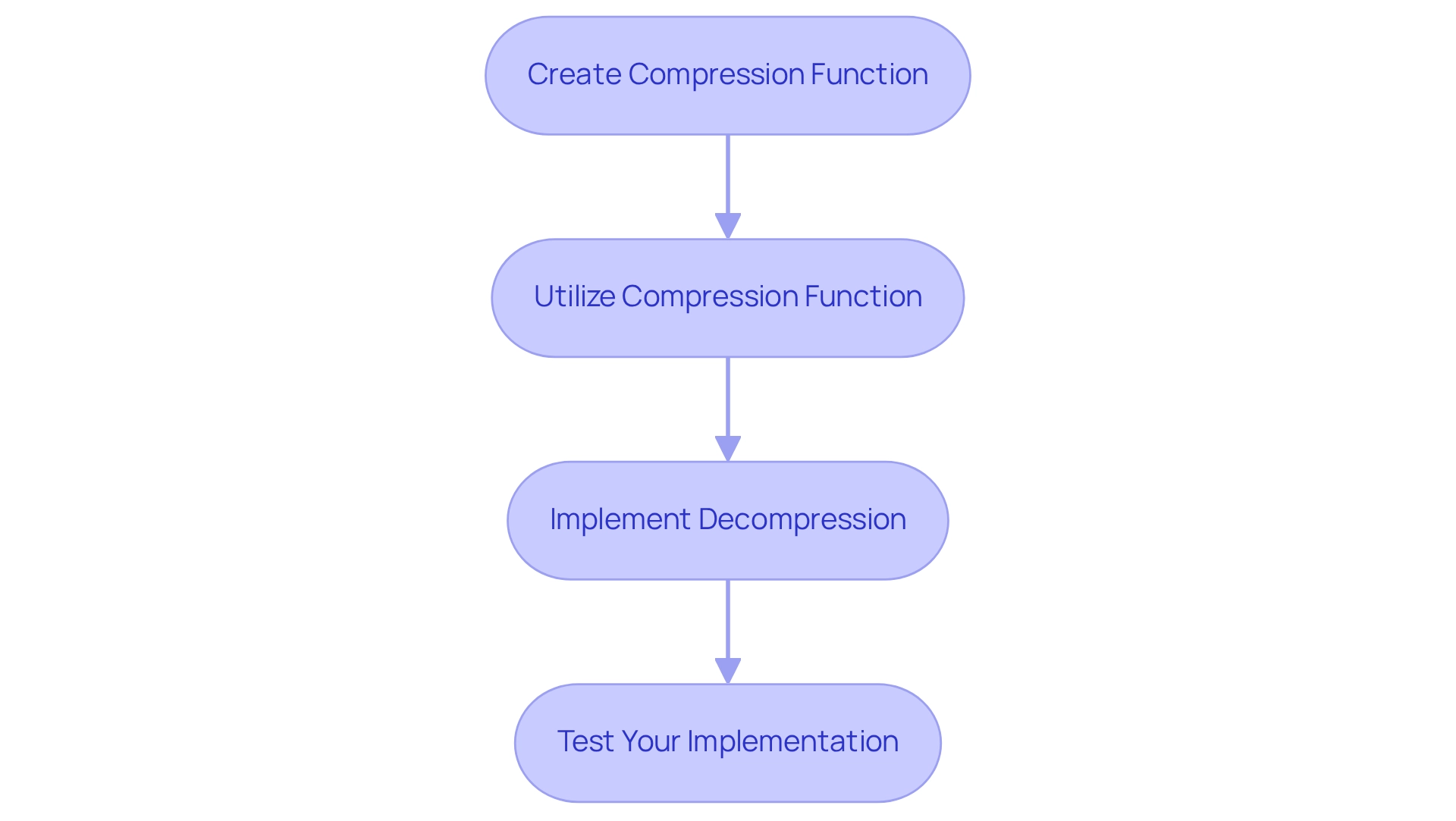
Test and Validate Your zstd Implementation
To effectively test and validate your zstd golang implementation, it is essential to follow a structured approach that addresses common coding challenges faced by developers.
-
Create Test Cases: Begin by developing comprehensive test cases that cover a variety of scenarios, including edge cases. The Go testing framework can be utilized to organize your tests effectively. For example:
func TestCompression(t *testing.T) { originalData := []byte("Test data for compression") compressed, err := compressData(originalData) if err != nil { t.Fatal(err) } decompressed, err := decompressData(compressed) if err != nil { t.Fatal(err) } if string(originalData) != string(decompressed) { t.Errorf("Expected %s, got %s", originalData, decompressed) } }This ensures that your implementation functions correctly across various conditions.
-
Run Your Tests: Next, execute your tests using the command:
go testThis command will run all your test cases and report any failures, ensuring that your implementation behaves as expected. Notably, software and QA testers comprise 7.8% of developer roles worldwide, emphasizing the critical role of testing in software development.
-
Analyze Performance: Implement benchmarking to assess the effectiveness of your data handling and decompression functions. Create benchmark tests to measure execution time, as shown below:
func BenchmarkCompress(b *testing.B) { for i := 0; i < b.N; i++ { compressData([]byte("Benchmarking zstd compression")) } }This step is vital for identifying performance bottlenecks.
-
Validate Results: Finally, confirm that the outputs of your tests align with the expected results and that performance benchmarks fall within acceptable limits. This validation is crucial for maintaining the integrity and efficiency of your application. As the software testing landscape continues to evolve, it is important to emphasize quality assurance, making rigorous testing practices essential.
By rigorously testing and validating your zstd golang implementation, you ensure its reliability and performance, which are essential in today’s evolving software landscape. According to Businessdocbox, there are 5.2 software testers per capita per 100,000 people worldwide, underscoring the significance of testing in the industry.
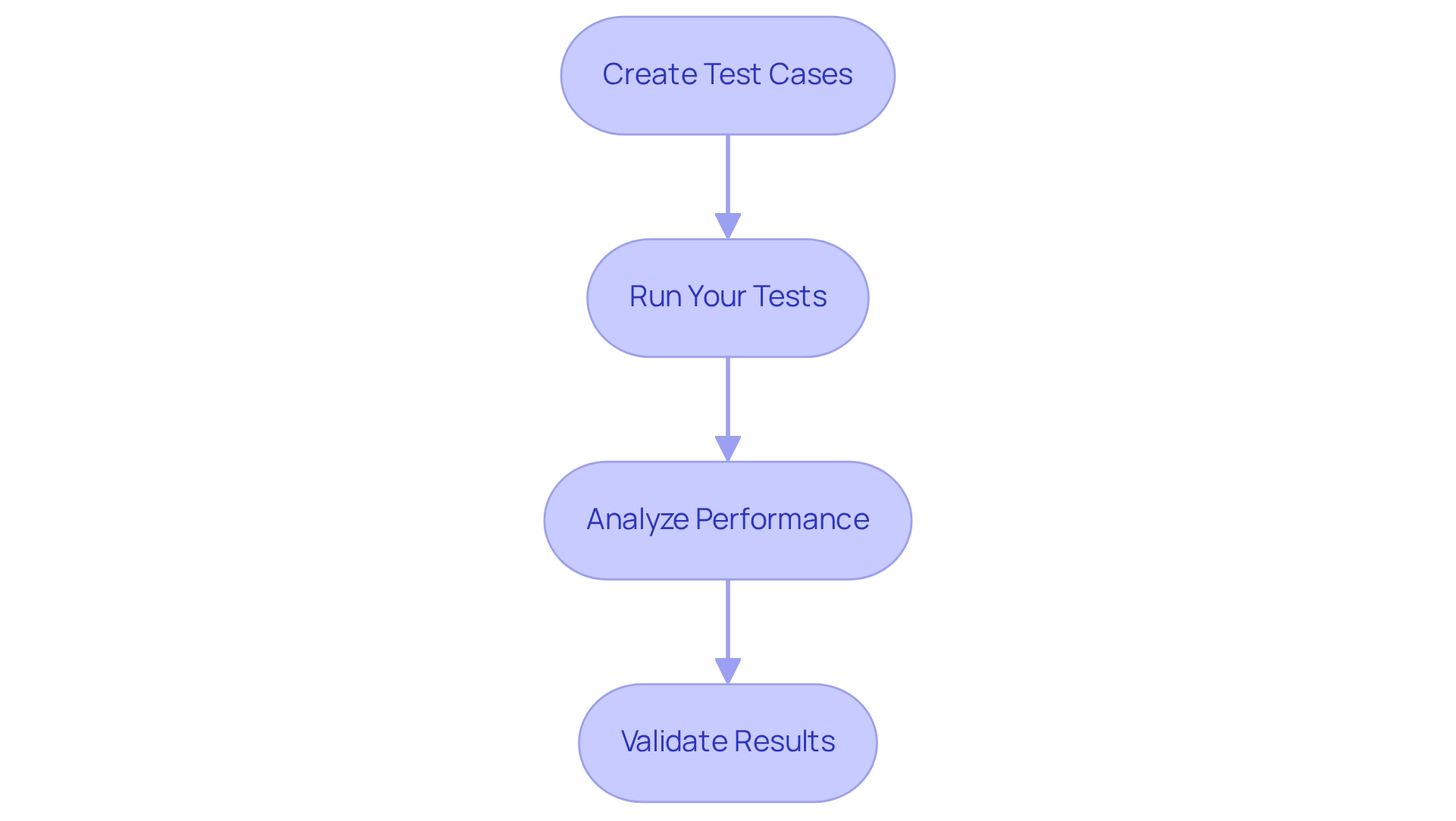
Conclusion
In the ever-evolving landscape of software development, developers face significant challenges related to efficient data handling. Zstandard (zstd) emerges as a powerful solution, offering superior compression ratios and rapid speeds compared to traditional algorithms like gzip. By minimizing file sizes and enhancing resource usage, zstd not only improves performance but also meets the growing demands of modern computing.
Implementing zstd in Golang projects is straightforward when developers prepare their environments properly and adhere to best practices for integration and testing. Establishing a solid development setup and rigorously validating the implementation ensures that zstd can be effectively utilized to enhance application efficiency. Real-world examples demonstrate the tangible benefits of adopting zstd, showcasing significant performance improvements that can be achieved through its use.
In today's data-driven environment, embracing zstd can lead to substantial advantages in both speed and resource management. As organizations increasingly recognize the importance of effective data handling, the transition towards zstd is likely to accelerate, solidifying its status as a preferred compression solution in the tech industry. By integrating zstd into their projects, developers are not merely adopting a tool; they are positioning themselves at the forefront of modern software development practices.
Frequently Asked Questions
What is Zstandard (zstd)?
Zstandard (zstd) is a high-performance, lossless data reduction algorithm developed by Facebook, specifically designed for real-time applications.
What are the advantages of using Zstandard?
The advantages of Zstandard include superior compression ratios, rapid decompression speeds, versatile flexibility in data reduction levels, and efficient resource usage during decompression.
How does Zstandard's compression ratio compare to traditional algorithms?
Zstandard consistently surpasses traditional algorithms like gzip, achieving a remarkable compression ratio of 2.896.
What are the decompression speeds of Zstandard?
Zstandard can achieve decompression rates of up to 1550 MB/s, making it suitable for applications that require quick access to information.
How does Zstandard allow for flexibility in data reduction?
Zstandard offers a broad spectrum of levels for data reduction, enabling developers to find the right balance between speed and effectiveness based on their project needs.
Why is efficient resource usage important in Zstandard?
Zstandard is designed to minimize CPU usage during decompression, which is particularly beneficial for applications that frequently access compressed data, ensuring optimal performance without excessive resource consumption.
What is the significance of training dictionaries in Zstandard?
Training dictionaries on coherent datasets can significantly enhance reduction ratios and speeds, showcasing the capabilities of Zstandard in real-world applications.
How is Zstandard being adopted in the industry?
The transition to Zstandard from older algorithms like gzip is becoming more common due to its superior performance and adaptability, with companies like Facebook adopting it in production environments.
What should developers do to implement Zstandard in their Golang projects?
Developers should establish a well-prepared development environment by downloading Go, organizing project files, ensuring compatibility with Go versions, and configuring environment variables like GOPATH and GOROOT.
What tools may enhance the workflow for Golang projects using Zstandard?
Additional tools such as code editors (e.g., Visual Studio Code) and version control systems (e.g., Git) can enhance the workflow for Golang projects utilizing Zstandard.




